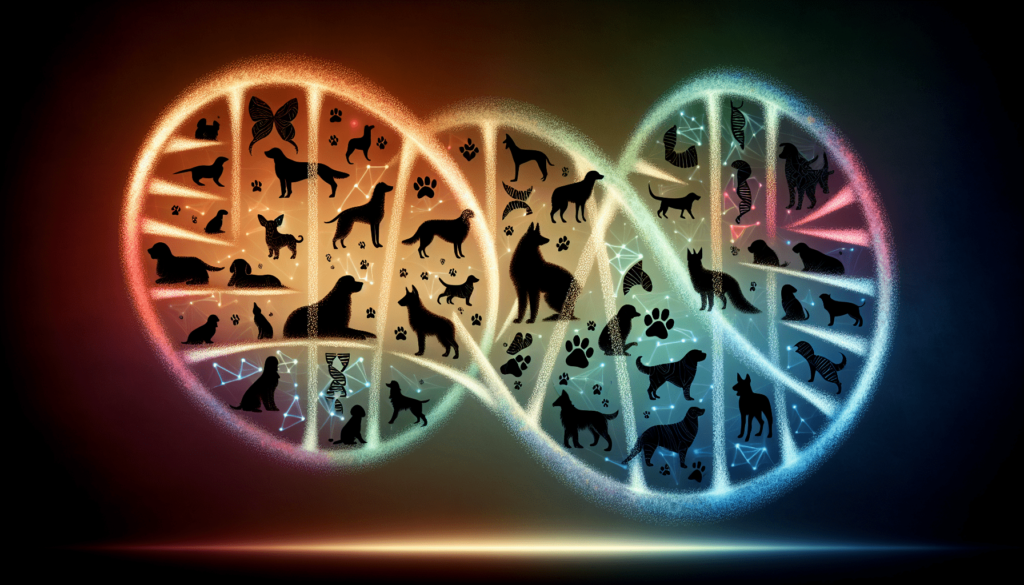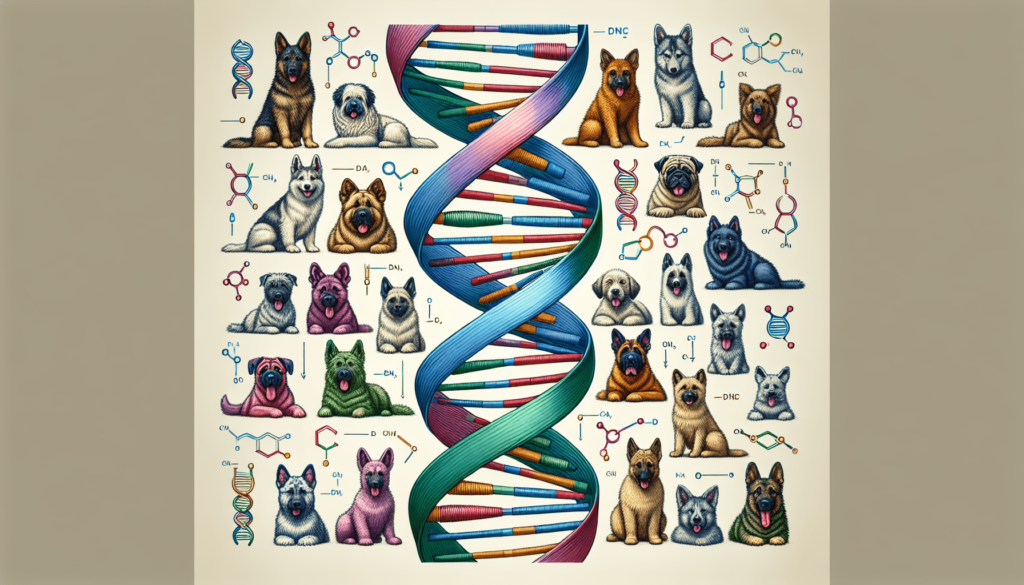Imagine discovering that behind the seemingly endless variety of dog breeds lies a captivating world of genetics. Have you ever wondered how certain breeds have distinct physical traits or unique behavior tendencies? The fascinating genetics of dog breeds reveal a complex interplay of genes that contribute to their individual characteristics and appearances. From the striking coat patterns of Dalmatians to the adorable wrinkled faces of Bulldogs, this article will take you on a journey into the remarkable genetic makeup of our beloved canine companions. Prepare to be amazed by the hidden science behind the diversity of dogs!
The history of dog breeds
The origins of dog domestication
The history of dog breeds dates back thousands of years, with the domestication of dogs believed to have occurred around 15,000 years ago. The exact origins of dog domestication are still debated among scientists, but many believe that dogs evolved from wolves who started to live alongside humans. These early domesticated dogs served various purposes, such as hunting, herding, and companionship.
The development of different breeds
As humans began to recognize the diverse and specialized abilities of dogs, they started selectively breeding them to enhance specific traits. This led to the development of different breeds, each with their own unique characteristics and purposes. Over time, breeding programs focused on creating dogs with specific physical attributes, temperaments, and skills, leading to the vast array of breeds we have today.
The role of genetics in breed formation
Genetics played a crucial role in the formation of different dog breeds. Selective breeding allowed breeders to manipulate the genes responsible for various traits such as size, coat color, and temperament. By selectively breeding dogs that possessed desired traits and excluding those without them, breeders were able to establish breed standards. These standards specify the characteristics that distinguish one breed from another, ensuring consistency in appearance and behavior.
Genetic variations within breeds
Understanding the concept of genetic diversity
Genetic diversity refers to the variety of genetic traits within a population. Within dog breeds, there can be significant genetic variation, even though they are considered to be a single breed. This variation is essential for the overall health and well-being of the breed, as it allows for the ability to adapt to changing environments and resist genetic disorders. Loss of genetic diversity through excessive inbreeding can have detrimental effects on breed health.
Inbreeding and its impact on breed health
Inbreeding, the mating of closely related individuals within a breed, can have negative consequences on breed health. While controlled inbreeding can help establish and maintain desirable traits, excessive inbreeding increases the risk of inheriting genetic disorders and reduces genetic diversity. With limited genetic variation, breeds become more susceptible to certain health conditions and may struggle to adapt to new challenges.
Identifying genetic markers for specific traits
Advances in genetic research have allowed scientists to identify specific markers within a dog’s DNA that are associated with certain traits. Through genome mapping and genetic studies, researchers have been able to pinpoint the genes responsible for coat color, size, and other physical traits. This knowledge not only provides valuable insights into breed history and evolution but also allows breeders to make informed decisions when selecting breeding pairs.

The genetics of physical traits
How genes determine coat color and pattern
Coat color and pattern in dogs are determined by a combination of genetic factors. Different genes control the production and distribution of pigments, resulting in the wide variety of colors seen in dog breeds. For example, the presence of the gene responsible for producing the pigment eumelanin determines whether a dog’s coat will be black or brown. Understanding these genetic mechanisms has enabled breeders to selectively breed for specific coat colors and patterns.
The genetic basis of size and body structure
The size and body structure of a dog are strongly influenced by genetics. Genes regulate the growth and development of bones, muscles, and organs, ultimately determining a dog’s size, proportions, and overall structure. Small dogs tend to have specific genes that promote reduced growth and size, while larger dogs have genes that support increased growth. By selectively breeding for desired sizes and proportions, breeders can create breeds with distinct body types.
The role of genetics in determining eye and ear shape
The shape and characteristics of a dog’s eyes and ears are also determined by genetics. Genes control the formation of eye structures, such as the shape of the eyelids and the color of the iris. Similarly, genes influence the size, shape, and position of a dog’s ears. Breed standards often specify the desired eye and ear shapes, and breeders use their knowledge of genetics to produce puppies that conform to these standards.
The genetics of temperament
The influence of genetics on behavior and personality
A dog’s behavior and personality are influenced to a significant extent by genetics. Genes play a role in determining a dog’s temperament, including factors such as aggression, sociability, and trainability. Certain breeds are known for their specific temperamental traits, such as the high-energy nature of Border Collies or the calm and gentle nature of Golden Retrievers. While environmental factors also contribute to a dog’s behavior, genetics lay the foundation for their natural predispositions.
Breed-specific temperamental traits
Different dog breeds are often associated with specific temperamental traits. These traits were initially selected and bred for based on the needs and purposes of the breed. For example, herding breeds like Border Collies were bred for intelligence, trainability, and the ability to work independently. On the other hand, breeds like Labrador Retrievers were selected for their friendly and gentle nature, making them excellent family companions. Understanding these breed-specific temperamental traits can help owners choose a dog that aligns with their lifestyle and expectations.
The relationship between genetics and trainability
Genetics can also play a role in a dog’s trainability. Certain breeds have a natural inclination for learning and obeying commands, while others may require more patience and effort during training. Genes associated with intelligence, problem-solving, and the desire to please humans influence a dog’s trainability. By understanding the genetic predispositions of different breeds, trainers and owners can tailor their training methods to maximize success.

The health implications of breed genetics
Genetic predisposition to certain diseases
Certain dog breeds are genetically predisposed to specific diseases and health conditions. These breed-specific genetic predispositions can be attributed to the presence of specific genes or variations in gene sequences. For example, some breeds are more susceptible to hip dysplasia or certain types of cancer due to inherited genetic factors. Recognizing these genetic predispositions allows veterinarians and breeders to implement preventative measures and screenings to minimize the risk of these diseases.
Breed-specific health issues
In addition to genetic predispositions, some dog breeds are prone to a variety of health issues that arise from their genetic makeup. These breed-specific health problems can range from respiratory issues in brachycephalic breeds to heart conditions in certain spaniel breeds. Responsible breeders take these health concerns into account when selecting breeding pairs and work towards improving the overall health of the breed.
The importance of genetic testing in breed health
Genetic testing has become an invaluable tool in identifying and managing breed-specific health issues. By analyzing a dog’s DNA, veterinarians and breeders can identify genetic mutations or variations associated with certain diseases. This information allows for early detection and targeted interventions, such as selective breeding or specialized healthcare plans, to mitigate the impact of these conditions. Genetic testing also plays a crucial role in ensuring the health and well-being of breeding stock.
The impact of selective breeding
The goals and consequences of selective breeding
Selective breeding in dog breeds has both intended goals and unintended consequences. The primary aim of selective breeding is to produce dogs that conform to specific breed standards and possess desired traits. However, excessive focus on certain traits can lead to health issues and decreased genetic diversity within a breed. Balancing the preservation of breed characteristics with maintaining genetic diversity and overall breed health is a delicate task for responsible breeders.
Balancing preservation of breed characteristics with genetic diversity
Preserving breed characteristics while safeguarding genetic diversity is a challenge for breeders. Striving for breed purity and adhering strictly to breed standards can lead to limited gene pools and an increased risk of inherited disorders. To address this, responsible breeders carefully select breeding pairs to maximize genetic diversity and minimize the risk of inherited diseases. This balancing act ensures that breed-related traits are maintained while preserving the overall health and well-being of the breed.
Ethical considerations in breeding practices
Ethical considerations play a crucial role in responsible breeding practices. Breeders must prioritize the health, welfare, and quality of life of their dogs above particular physical or behavioral traits. This means breeding for genetic diversity, avoiding excessive inbreeding, and conducting genetic health tests to minimize the risk of inherited diseases. Ethical breeders also prioritize finding suitable homes for their puppies, ensuring they go to responsible owners who can meet their needs.
Unraveling the dog genome
The dog genome project
The dog genome project, initiated in 1999, aimed to sequence the entire canine genome and unravel the genetic makeup of dogs. This groundbreaking project involved sequencing the DNA of different dog breeds to identify and map genes responsible for various traits and diseases. The completed dog genome has since become a valuable resource for researchers, breeders, veterinarians, and dog enthusiasts alike.
Discoveries and insights from mapping the dog genome
Mapping the dog genome has provided numerous discoveries and insights into the genetics of dog breeds. Researchers have identified genes associated with coat color, size, and disease susceptibility, among many others. This knowledge has not only enhanced our understanding of the genetic basis of traits but also allows for the development of new genetic tests, targeted therapies, and breeding strategies to improve dog health and welfare.
The future of genetic research in dog breeds
As technology and research methods continue to advance, the future of genetic research in dog breeds holds great promise. Scientists will continue to refine our understanding of the genetic basis of traits and diseases, enabling more informed breeding decisions and personalized healthcare plans. Genome editing and genetic engineering techniques may also become viable options in the future, offering potential solutions to genetic disorders and promoting overall breed health.
Hybrid breeds and genetic diversity
Understanding hybrid vigor and its benefits
Hybrid vigor, also known as heterosis, refers to the increased health, vitality, and performance observed in hybrid offspring resulting from the mating of individuals from different breeds. By combining the genetic diversity of two or more breeds, hybrid dogs often exhibit improved disease resistance and overall well-being. This inherent genetic diversity can reduce the risk of inherited disorders and enhance the overall quality of life for these dogs.
The popularity and controversies surrounding designer breeds
Designer breeds, which are intentional crosses between two purebred dogs, have gained popularity in recent years. These breeds, such as Labradoodles or Goldendoodles, combine the desirable traits of their parent breeds. However, controversy surrounds designer breeds due to concerns about inconsistency in temperament and health issues resulting from unpredictable genetics. Those interested in designer breeds should thoroughly research the reputability of the breeder and consider the potential risks associated with these crossed breeds.
The potential impact on purebred populations
The rise of hybrid and designer breeds has led to concerns regarding the impact on purebred populations. Some worry that increased demand for hybrids could result in a decline in the popularity and genetic diversity of purebred dogs. Responsible breeders and organizations work to educate the public about the importance of preserving purebred breeds and their unique characteristics, while also emphasizing the benefits of responsible hybrid breeding practices.
The role of genetics in breed identification
Using DNA testing to determine breed heritage
DNA testing has revolutionized the ability to determine a dog’s breed heritage accurately. Through the analysis of a dog’s genetic material, laboratories can identify the presence or absence of specific genetic markers associated with various breeds. This testing can provide insight into a dog’s ancestry and help owners better understand their dog’s physical and behavioral traits.
Challenges in accurate breed identification
Despite the advancements in DNA testing, accurate breed identification can still be challenging. Some breeds share similar genetic markers, making it difficult to distinguish between them definitively. Additionally, mixed breed dogs with complex ancestry may pose difficulties in identifying all the breeds present in their genetic makeup. While DNA testing offers valuable information, it is essential to understand its limitations and consult with professionals who can interpret the results accurately.
Breed misidentification and its implications
Breed misidentification, whether intentional or unintentional, can have significant implications for both owners and dogs. Misidentification can result in misconceptions regarding a dog’s behavior, instincts, and health risks. For example, a dog falsely labeled as a specific breed may not receive appropriate care or training tailored to their actual genetic heritage. Accurate breed identification is crucial for ensuring proper understanding and care for our four-legged friends.
Genetics and the future of dog breeds
The potential for genetic engineering in breeding
As technology advances, the potential for genetic engineering in dog breeding becomes a topic of interest and debate. Genetic engineering techniques, such as gene editing, offer the possibility of modifying specific genes to eliminate genetic disorders or enhance desired traits. However, ethical considerations and careful regulation are necessary to ensure the responsible and thoughtful application of these technologies in the best interest of the dogs.
Genetic technologies and their impact on breed health and diversity
Genetic technologies continue to shape the future of dog breeds by providing powerful tools for improving breed health and maintaining genetic diversity. Genetic tests can identify specific disease-causing mutations, allowing breeders to make informed breeding decisions. Additionally, advancements in reproductive technologies, such as artificial insemination and embryo transfer, offer new possibilities for preserving genetic diversity and combating inherited disorders.
The ethical implications of genetic manipulation in animal breeding
The ethical implications of genetic manipulation in dog breeding are a topic of ongoing discussion and deliberation. While genetic technologies offer potential benefits, such as disease prevention and improved well-being, ethical concerns surrounding animal welfare, consent, and the potential for unintended consequences need to be carefully considered. Responsible breeding practices should prioritize the overall health and welfare of the dogs and the preservation of breed characteristics without compromising genetic diversity.

